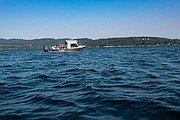Our Gem: Who’s the National Academy of Sciences, and what do they want with Our Gem, Coeur d’Alene Lake?
Since the beginning of this year, the National Academy of Sciences (NAS) has been reviewing historical and recent water quality data from Coeur d’Alene (CDA) Lake. The NAS assembled a committee composed exclusively of volunteer experts to assess water quality and provide possible recommendations. Our lake has seen a decline in metal concentrations in the decades since enacting environmental regulations. However, increased development has raised concerns that CDA Lake may be at risk of going hypoxic. In layman’s terms, the NAS is looking at trends in data regarding levels of nutrients and dissolved oxygen to determine if those trends could result in the release of sediment-bound heavy metals. You may be wondering, who is the National Academy of Sciences?
The National Academy of Sciences is one of the oldest American institutions, created in 1863, by President Abraham Lincoln, only a few months before his legendary Gettysburg Address. At the height of the Civil War, a group of scientists advocated the charter of an academy for the government to call upon to investigate, examine, experiment, and report upon scientific matters, with no compensation for any services. The academy appoints experts to provide independent and objective advice to the nation on matters related to science and technology. Their reports have repeatedly shaped public policy for the last 158 years.
The government rarely called upon the NAS before World War 1. When reports of the German’s use of chemical weapons surfaced, the necessity of a robust scientific body was realized. The NAS laid the groundwork to become the official organizer of national and international scientific forces. President Woodrow Wilson approved the incorporation of the National Research Council, via Executive Order No. 2859, to secure the cooperation of military and civilian agencies. Intensive collaborations began with the UK, France, and Italy to support the war effort through scientific research and development. Vigorous work started on various topics, including aviation, synthetic drugs, tanks, machine guns, and psychology.
The NAS reported on the first known, widespread “shell shock” phenomena of soldiers returning home from World War 1. This phenomenon, now known as post-traumatic stress disorder (PTSD), was thought to result from physical injury to the nervous system. PTSD, or shell shock, was a poorly understood condition. The NAS’s study revealed that soldiers not directly exposed to heavy bombardment suffered equally as those who were physically injured. The traumatized soldiers experienced fatigue, tremors, confusion, nightmares, and impaired vision and hearing, without any visible wounds. This discovery encouraged psychologists to join the efforts of the Army’s Medical Department, and we now have a much deeper understanding and recognition of PTSD.
The National Academy of Sciences has a reputation for producing comprehensive consensus reports on controversial scientific issues. The NAS publishes about one report a day, covering such topics as environmental health, gene editing, human rights, education, origins of the universe, renewable energy, climate change, and many others. The NAS’s member scientists are recognized consistently for their outstanding contributions. An astonishing 500 deceased and current members of the NAS have been awarded Nobel Prizes for their work.
“The Future of Water Quality in Coeur d’Alene Lake” is a current focus of study for the NAS. Our lake has gained the attention of an ad hoc committee of expert ecologists, environmental engineers, geoscientists, hydrologists, civil engineers, chemical and biological engineers, and many others. The NAS hosts private, as well as open, public sessions in which your involvement is encouraged. The committee members will travel to Coeur d’Alene to conduct site visits, host a meet and greet, and meet with the study’s sponsors on Sept. 29 and 30 of this year.
For more information on the study, please visit: bit.ly/CDAlakestudy
• • •
The Our Gem Coeur d’Alene Lake Collaborative is a team of committed and passionate professionals working to preserve lake health and protect water quality by promoting community awareness of local water resources through education, outreach and stewardship. Our Gem includes local experts from the University of Idaho Community Water Resource Center, Coeur d’Alene Tribe Lake Management Department, Idaho Department of Environmental Quality, Kootenai Environmental Alliance, Kootenai County, Coeur d’Alene Regional Chamber and CDA 2030.



